Northern Norway’s Arctic Landscapes Are the Best Place to Unplug — With Nighttime Skiing and Cozy Historic Farmsteads
For a snow-cloaked adventure, author Heine Bakkeid revisits the wild fjords and forests that shaped him, and forges new paths along the way.
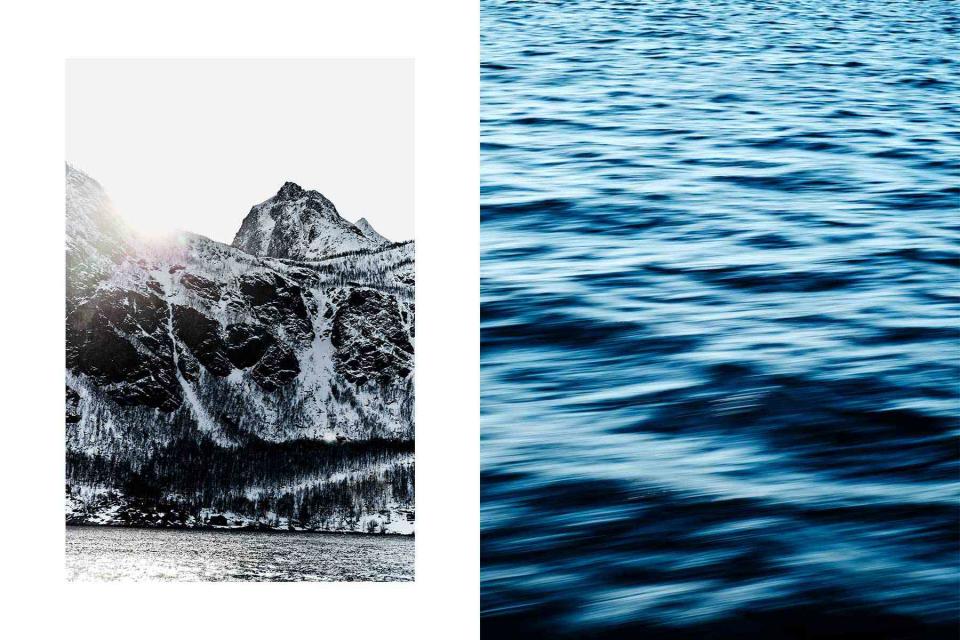
Øivind Haug
From left: Årbostadtinden, one of many peaks on Andørja that top 3,000 feet; rippling water seen from the ferry.When I tell people that writing is my life, I really mean it. The process consumes me, especially during the winter months when I rarely see anyone outside my family. My mystery novels tend to be on the darker side of the Nordic Noir genre; their protagonist, the troubled former police officer Thorkild Aske, is a completely broken man. Each new installment takes quite a toll on me. Still, I am always giddy starting on the next project. In some ways, the beginning always feels like an adventure — never really knowing what awaits around the next bend, over the next hill.
In February of 2021, I delivered my latest manuscript, St. Avenger, to my editors. I had spent almost two years on it — two years researching, writing, and trying to understand the people on both sides of the line between good and evil. By the time I had finished, I desperately needed to clear my head. Usually I would go traveling, find someplace to reset, enjoy some good food, have an adventure out in the world. But this time there was a pandemic going on. My options were limited.
I live on the island of Hinnøya, just outside the town of Harstad, in northern Norway — a land of mountains and sea, and some forest in between. The vastness of the place reminds me of my childhood in nearby Belnes, an Arctic village made up of only five houses. As a kid, I often went on adventures on my own, by the shore, in the woods, or up on the mountain plateau, leaving the world behind. After finishing the new book, I decided it was time to do it again — to reacquaint myself with the open spaces of my childhood, and to once again let them engulf me.
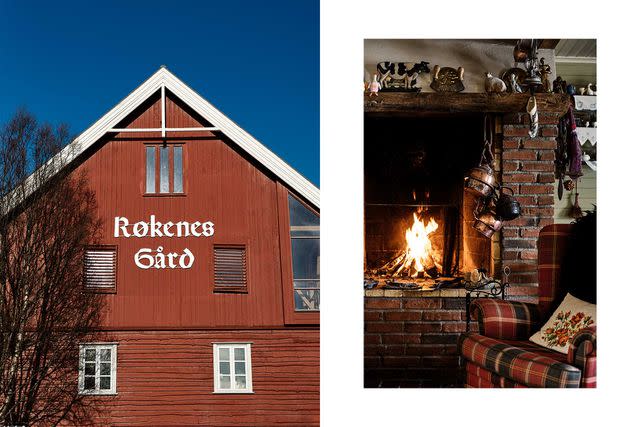
Øivind Haug
From left: The farmhouse at Røkenes Gård, a historic estate near Harstad.I began by making a reservation at Røkenes Gård, a farmstead that’s been run by the same family for 10 generations, to learn more about the history of the land I grew up on. The estate is located just outside Harstad, on the Bay of Bergsvågen. This area was cleared for agriculture as early as the fourth century A.D., and was in use throughout Viking times and the Middle Ages. It’s now home to an acclaimed hotel and restaurant, but ingredients still come from the rich farmland nearby and the sea beyond.
According to owner Kristian Fredrik Kulseng, the food philosophy at Røkenes combines traditional recipes with seasonal sourcing. I ate crisp pan-fried cod from Myre, in the Vesterålen archipelago, accompanied by a carrot cream; shredded cabbage sautéed with butter and home-smoked bacon; baked small red potatoes from the island of Grytøya; and a kefir panna cotta with local berries.
While dining, I looked out over the fjords, the mountains, and the islands of Rolla and Andørja to the east. Suddenly, I got a glimpse of myself as a kid, watching my grandfather working outside while my grandmother fried cod at the stove. My parents were only teenagers when I was born — young love, right? — and for a time we lived on Rolla with my grandparents. My uncle still lives in that house, and our family has a summer home there. But after Røkenes, I decided to visit the neighboring island, Andørja, just a ferry ride away (it’s also connected to Rolla by an underwater tunnel). Andørja is northern Europe’s most mountainous island; its tallest peak, Langlitinden, rises 4,200 feet above sea level.
A winter storm was brewing even before I left for Engenes, a fishing village on Andørja’s northwestern corner. But I was impatient for the nighttime silence, the wilderness, the cold metal of the winter sky. I’d contacted Andørja Adventures, a tour operator that can also help visitors rent a rorbu — one of the seasonal fishermen’s cabins that line the Norwegian coast, now popular as holiday homes. The company has a long track record of setting up more extreme activities, like fjord fishing and whale safaris; I wanted to go cross-country night-skiing, like I used to when I was a kid.
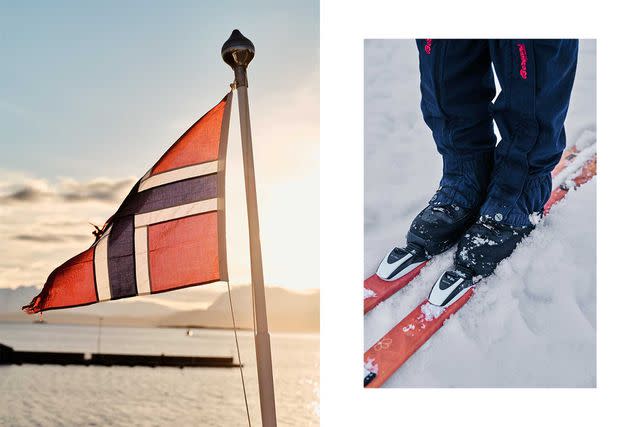
Øivind Haug
From left: The Norwegian flag flies over Harstad harbor; Andørja Adventures can organize trips centered around cross-country skiing, a beloved pastime in northern Norway.But before heading to the mountains, I was excited to see a new project from Andørja Adventures founder Terje Hansen: the Arctic Shark Center, which is set to become one of the region’s most spectacular tourism initiatives. A scientific facility built in collaboration with the University of Tromsø–Arctic University of Norway, the center was designed to attract visitors with a combination of ecology, architecture, and local food and drink. Its buildings draw their form from the shape and movement of the Greenland shark, which is native to these waters. One structure, nicknamed Haihuset, or the Shark House, meanders toward the open sea; the other, Parasitten, or the Parasite, mimics the shape of an organism that lives in the eyes of almost all Greenland sharks. The complex is also home to four rorbuer, which will be replaced by a luxury hotel and restaurant — just feet from where the sea comes crashing in.
DNA research takes place in the Shark House, where I met professor Kim Præbel, who gave me a tour of the operations. After we watched a live stream of images and sounds from 1,600 feet below the surface of the fjord, Præbel explained a pioneering technique called metabarcoding, which the university uses to assess marine biodiversity. “It allows us to find the DNA signature of every creature living in a specific part of the ocean, using only three half-liter samples of water,” he explained. “We can count the number of organisms in that area without even going out in a boat.”
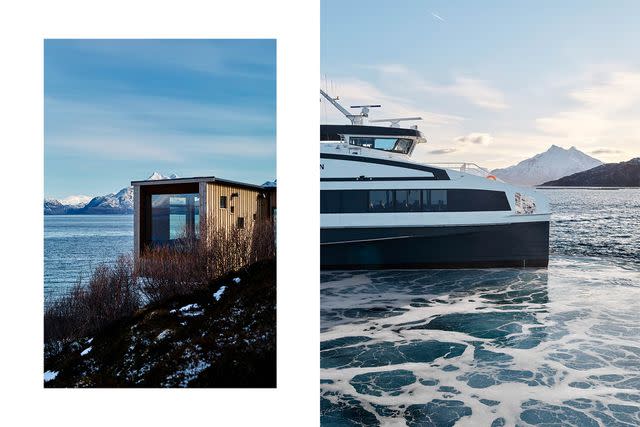
Øivind Haug
A building at the Arctic Shark Center, a research facility on Andørja; the ferry that connects Harstad to Andørja.“Let’s say we were at a crime scene, professor,” I wondered aloud. “Could the police ‘vacuum’ a room and find DNA the same way?” Perhaps I had found material for my next novel. Through the window, all we could see was a weak glimmer way out in the fjord, where skeletal beams of moonlight broke through the clouds to illuminate the surface of the ocean.
After waving goodbye to the professor, I packed my rucksack and drove a couple of miles into the forest to don my ski gear. The rain had compressed the snow, so the cross-country trails were perfect, even for my wax-free skis. The wind was still howling — but as soon as I got away from the ocean and into the trees, the dying storm manifested as little more than a squeaking whisper between the branches. It was so dark I put on a headlamp — no northern lights, no stars or moon, just inkiness all around me.
After about an hour of skiing, I set up at a gapahuk, a traditional wooden lean-to used for camping and fishing, and began to make a fire. I’d had a lunch of hearty bread, ham, and sausage with whole peppercorns. Now I unwrapped my dinner: meatballs, fried potatoes, and root vegetables in foil for cooking on the fire. For dessert, fresh-baked cookies and dark-roast bonfire coffee.
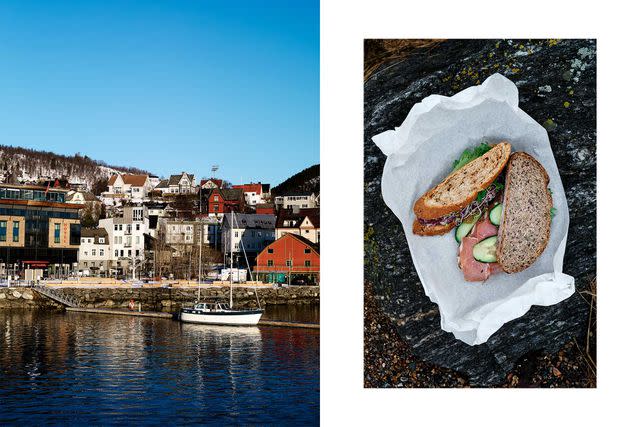
Øivind Haug
From left: A winter view of the Harstad waterfront; sandwiches with house-made ham from Refsnes Matglede, on Hinnøya.The storm clouds were breaking up. The dying fire eventually burned out. For a short while, everything was completely dark. Then, suddenly, I was surrounded by moonlight, an amazing metallic aura with shades of black and blue that illuminated the sky, the trees, the mountains and snow. The feeling came rushing through my body all at once.
I’d been longing for the wide-open spaces of my childhood, but looking into the forest, it struck me that a wide-open space also existed between me and my younger self. Time only expands outward, never looking back; I couldn’t reset the clock, only acknowledge it, accept it. And maybe get a quick glimpse of that kid again, out here in his forever-place.
A Slice of Northern Norway
Andørja Adventures: Fishing trips, boat and rorbu rentals, and activities like hiking and skiing have been this tour operator’s domain for more than 25 years.
Arctic Shark Center: The founder of Andørja Adventures collaborated with the Arctic University of Norway on this combination research station, citizen-science base, hotel, and restaurant, all slated to open to the public by late 2023 and early 2024.
Refsnes Matglede: For a day of exploring Hinnøya, pick up provisions at this specialty-food store in Borkenes, west of Harstad, which spotlights local ingredients.
Røkenes Gård: This inn on a historic farmstead also has a popular restaurant (reservations strongly encouraged) that sources from the fertile countryside around Harstad.
How to Book
A Scandinavia specialist on T+L’s A-List of top travel advisors, Melissa Lee can create a northern Norway itinerary that incorporates ski resorts, Arctic villages, and remote islands like the Lofoten Archipelago.
A version of this story first appeared in the December 2022/January 2023 issue of Travel + Leisure under the headline "Wide Winter Skies."
For more Travel & Leisure news, make sure to sign up for our newsletter!
Read the original article on Travel & Leisure.

